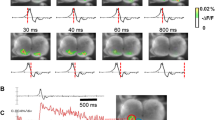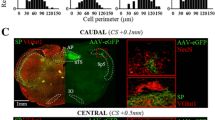Abstract
We examined respiratory neurons in the Bötzinger complex of the medulla oblongata in 18 vagotomized, paralyzed, ventilated, and decerebrated rats and tested the hypothesis that bulbospinal expiratory neurons in this region monosynaptically inhibit phrenic motoneurons. First, we surveyed the types of respiratory neurons found in the Bötzinger complex; only 11 of the 98 (∼11%) examined were bulbospinal, and all discharged only during late expiration (E2), usually with an augmenting discharge frequency (AUG). Then, we examined the spinal projections of 34 E2-AUG neurons using antidromic activation and found that all projected as far as the C4 or C5 segments of the spinal cord but no further caudally. Most (30, ∼88%) had only unilateral projections, the majority (25, ∼83%) ipsilateral, but 4 neurons (∼12%) had bilateral projections. Their axons could be antidromically activated at low currents (less than 10 μA) in the dorsal-lateral part of the spinal cord at the C2–3 border; 0.5–1.2 mm (mean±SD 0.84±0.23 mm) below the dorsal surface and 0.7–1.5 mm (1.19±0.25 mm) lateral from the midline. We sought evidence for connections from bulbospinal E2-AUG neurons to 118 phrenic motoneurons by computing spike-triggered averages (STAs) of their intracellular potentials triggered by the action potentials of 38 unilaterally-projecting E2-AUG neurons. Resting phrenic motoneuron membrane potentials ranged from –40 to –75 mV (–56±8 mV) and fluctuations with the respiratory cycle from 7 to 20 mV (14±4 mV). Of the 118 STAs computed, hyperpolarizations were evident in 18 (∼15%) STAs, evoked by 11 of 38 (∼29%) E2-AUG neurons. Their amplitudes varied from 35 to 550 μV (105±113 μV), 10–90% fall times from 0.4 to 0.9 ms (0.63±0.17 ms), and half-amplitude widths from 1.3 to 3.2 ms (2.0±0.52 ms). Most (16/95, ∼17%) of the STAs that displayed hyperpolarizations were associated with ipsilateral trigger neurons but some (2/23, ∼9%) resulted from contralateral trigger neurons. We conclude that Bötzinger-complex, expiratory neurons project to the C4 and/or C5 segments of the cervical spinal cord but no further caudal. Their axons are located dorsolaterally in the upper cervical segments of the spinal cord, and they monosynaptically inhibit phrenic motoneurons during the late part of expiration.
Similar content being viewed by others
Author information
Authors and Affiliations
Additional information
Received: 27 January 1998 / Accepted: 22 April 1998
Rights and permissions
About this article
Cite this article
Tian, GF., Peever, J. & Duffin, J. Bötzinger-complex expiratory neurons monosynaptically inhibit phrenic motoneurons in the decerebrate rat. Exp Brain Res 122, 149–156 (1998). https://doi.org/10.1007/s002210050502
Issue Date:
DOI: https://doi.org/10.1007/s002210050502




